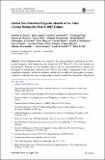Files in this item
Global non-potential magnetic models of the solar corona during the March 2015 eclipse
Item metadata
| dc.contributor.author | Yeates, A. R. | |
| dc.contributor.author | Amari, Tahar | |
| dc.contributor.author | Contopoulos, Ioannis | |
| dc.contributor.author | Feng, Xueshang | |
| dc.contributor.author | Mackay, D. H. | |
| dc.contributor.author | Mikić, Zoran | |
| dc.contributor.author | Wiegelmann, Thomas | |
| dc.contributor.author | Hutton, Joseph | |
| dc.contributor.author | Lowder, Christopher A. | |
| dc.contributor.author | Morgan, Huw | |
| dc.contributor.author | Petrie, Gordon | |
| dc.contributor.author | Rachmeler, L. A. | |
| dc.contributor.author | Upton, Lisa A. | |
| dc.contributor.author | Canou, Aurelien | |
| dc.contributor.author | Chopin, Pierre | |
| dc.contributor.author | Downs, Cooper | |
| dc.contributor.author | Druckmüller, Miloslav | |
| dc.contributor.author | Linker, Jon A. | |
| dc.contributor.author | Seaton, Daniel B. | |
| dc.contributor.author | Török, Tibor | |
| dc.date.accessioned | 2018-08-13T12:30:05Z | |
| dc.date.available | 2018-08-13T12:30:05Z | |
| dc.date.issued | 2018-08 | |
| dc.identifier | 255271262 | |
| dc.identifier | c7326d4d-a769-46b4-87fc-7f54d1cb3c2c | |
| dc.identifier | 85051104176 | |
| dc.identifier | 000441227600001 | |
| dc.identifier.citation | Yeates , A R , Amari , T , Contopoulos , I , Feng , X , Mackay , D H , Mikić , Z , Wiegelmann , T , Hutton , J , Lowder , C A , Morgan , H , Petrie , G , Rachmeler , L A , Upton , L A , Canou , A , Chopin , P , Downs , C , Druckmüller , M , Linker , J A , Seaton , D B & Török , T 2018 , ' Global non-potential magnetic models of the solar corona during the March 2015 eclipse ' , Space Science Reviews , vol. 214 , no. 5 , 99 . https://doi.org/10.1007/s11214-018-0534-1 | en |
| dc.identifier.issn | 1572-9672 | |
| dc.identifier.other | ArXiv: http://arxiv.org/abs/1808.00785v1 | |
| dc.identifier.other | ORCID: /0000-0001-6065-8531/work/58055418 | |
| dc.identifier.uri | https://hdl.handle.net/10023/15812 | |
| dc.description | Funding: UK Science and Technology Facilities Council (STFC) (ARY, DHM). | en |
| dc.description.abstract | Seven different models are applied to the same problem of simulating the Sun’s coronal magnetic field during the solar eclipse on 2015 March 20. All of the models are non-potential, allowing for free magnetic energy, but the associated electric currents are developed in significantly different ways. This is not a direct comparison of the coronal modelling techniques, in that the different models also use different photospheric boundary conditions, reflecting the range of approaches currently used in the community. Despite the significant differences, the results show broad agreement in the overall magnetic topology. Among those models with significant volume currents in much of the corona, there is general agreement that the ratio of total to potential magnetic energy should be approximately 1.4. However, there are significant differences in the electric current distributions; while static extrapolations are best able to reproduce active regions, they are unable to recover sheared magnetic fields in filament channels using currently available vector magnetogram data. By contrast, time-evolving simulations can recover the filament channel fields at the expense of not matching the observed vector magnetic fields within active regions. We suggest that, at present, the best approach may be a hybrid model using static extrapolations but with additional energization informed by simplified evolution models. This is demonstrated by one of the models. | |
| dc.format.extent | 27 | |
| dc.format.extent | 8915636 | |
| dc.language.iso | eng | |
| dc.relation.ispartof | Space Science Reviews | en |
| dc.subject | Magnetic fields | en |
| dc.subject | Sun: surface magnetism | en |
| dc.subject | Sun: corona | en |
| dc.subject | QB Astronomy | en |
| dc.subject | QC Physics | en |
| dc.subject | 3rd-DAS | en |
| dc.subject.lcc | QB | en |
| dc.subject.lcc | QC | en |
| dc.title | Global non-potential magnetic models of the solar corona during the March 2015 eclipse | en |
| dc.type | Journal article | en |
| dc.contributor.sponsor | Science & Technology Facilities Council | en |
| dc.contributor.sponsor | Science & Technology Facilities Council | en |
| dc.contributor.sponsor | The Leverhulme Trust | en |
| dc.contributor.institution | University of St Andrews. Applied Mathematics | en |
| dc.identifier.doi | https://doi.org/10.1007/s11214-018-0534-1 | |
| dc.description.status | Peer reviewed | en |
| dc.identifier.grantnumber | ST/K000950/1 | en |
| dc.identifier.grantnumber | ST/N000609/1 | en |
| dc.identifier.grantnumber | RPG-305 | en |
This item appears in the following Collection(s)
Items in the St Andrews Research Repository are protected by copyright, with all rights reserved, unless otherwise indicated.

